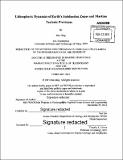| dc.contributor.advisor | Jian Lin. | en_US |
| dc.contributor.author | Ding, Min | en_US |
| dc.contributor.other | Woods Hole Oceanographic Institution. | en_US |
| dc.coverage.spatial | zma---- | en_US |
| dc.date.accessioned | 2015-06-10T19:11:28Z | |
| dc.date.available | 2015-06-10T19:11:28Z | |
| dc.date.copyright | 2015 | en_US |
| dc.date.issued | 2015 | en_US |
| dc.identifier.uri | http://hdl.handle.net/1721.1/97340 | |
| dc.description | Thesis: Ph. D., Joint Program in Oceanography/Applied Ocean Science and Engineering (Massachusetts Institute of Technology, Department of Earth, Atmospheric, and Planetary Sciences; and the Woods Hole Oceanographic Institution), 2015. | en_US |
| dc.description | Cataloged from PDF version of thesis. | en_US |
| dc.description | Includes bibliographical references. | en_US |
| dc.description.abstract | This thesis investigates lithospheric dynamics of Earth's subduction zones and Martian tectonic provinces on multiple time scales ranging from short-term earthquake deformation to long-term tectonic loading. In Chapter 2, I use geodetic observations to constrain the postseismic viscoelastic deformation following the 1960 M9.5 Valdivia, Chile earthquake and quantify its stress loading on the rupture zone of the 2010 M8.8 Maule, Chile earthquake. Results of analysis reveal that the post-1960 viscoelastic process might have contributed to the triggering of the 2010 earthquake. Chapter 3 presents numerical experiments to investigate elastoplastic deformation and faulting in the overriding plates of subduction zones caused by the movement of subducted seamounts. Numerical simulations show that a group of normal faults would first appear on the seaward side of a subducted seamount, followed by a group of thrust faults on the landward side of the seamount. In Chapter 4, I use the most recent Martian gravity and topography data to constrain spatial variations in lithospheric flexural deformation for various tectonic regions on Mars. The effective lithospheric thickness is estimated to be relatively small for the plain regions in the southern highland, but relatively large for the impact basins in the northern lowland as well as for volcanic montes in the Tharis province. The regional variations in the estimated effective lithospheric thickness might reflect both spatial and temporal changes in the thermal state of Mars. | en_US |
| dc.description.statementofresponsibility | by Min Ding. | en_US |
| dc.format.extent | pages | en_US |
| dc.language.iso | eng | en_US |
| dc.publisher | Massachusetts Institute of Technology | en_US |
| dc.rights | M.I.T. theses are protected by copyright. They may be viewed from this source for any purpose, but reproduction or distribution in any format is prohibited without written permission. See provided URL for inquiries about permission. | en_US |
| dc.rights.uri | http://dspace.mit.edu/handle/1721.1/7582 | en_US |
| dc.subject | Joint Program in Oceanography/Applied Ocean Science and Engineering. | en_US |
| dc.subject | Earth, Atmospheric, and Planetary Sciences. | en_US |
| dc.subject | Woods Hole Oceanographic Institution. | en_US |
| dc.subject.lcsh | Subduction zones | en_US |
| dc.subject.lcsh | Morphotectonics | en_US |
| dc.title | Lithospheric dynamics of Earth's subduction zones and Martian tectonic provinces | en_US |
| dc.type | Thesis | en_US |
| dc.description.degree | Ph. D. | en_US |
| dc.contributor.department | Joint Program in Oceanography/Applied Ocean Science and Engineering | en_US |
| dc.contributor.department | Woods Hole Oceanographic Institution | en_US |
| dc.contributor.department | Massachusetts Institute of Technology. Department of Earth, Atmospheric, and Planetary Sciences | |
| dc.identifier.oclc | 910515777 | en_US |
